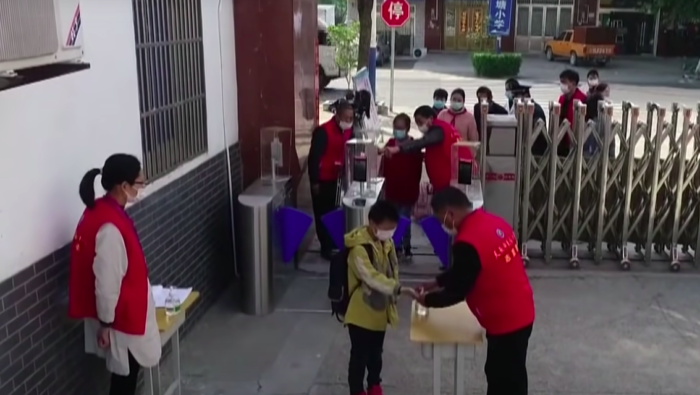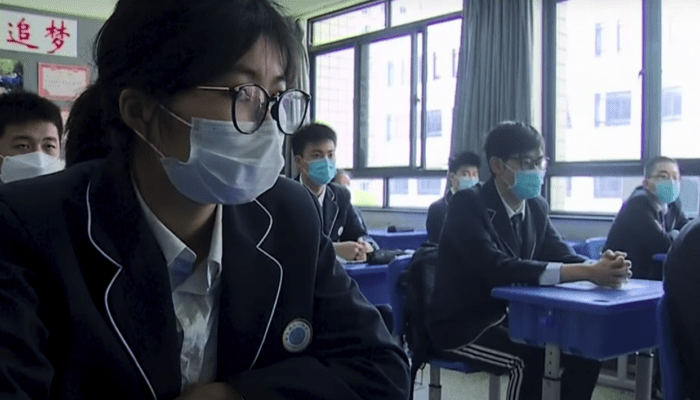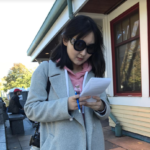
“Schools [should] bring back the students in person who most need to be in-person.”
Every school day, Zhao Xiaoyu, a Chinese elementary school teacher in Shanghai, slid on her phone to check her students’ body temperatures through “Huizhili,” a mobile app for the Shanghai Xuhui District’s parents to report their children’s temperatures. The school required parents to test at home and submit the results before 8 am every school day.
On one recent day, the screen showed that of a total 43 students, 43 submitted and had no fever. Zhao drove to school and got in the long line in front of the gate. There, people waited, six feet in between each other, until it was their turn to encounter four face-scanning thermometers.
When students are settled in classrooms, teachers use infrared thermometers to get every student’s temperature again, then submit to the school medical center. “But the facial-scanner thermometer is not always accurate,” Zhao explained.
“One day,” Zhao laughed, “every teacher and school faculty simultaneously received a message on their phones.” The message showed a photo of the vice president trying to enter the school’s left gate, his temperature was displayed, 109.04 degrees. The medical team immediately arrived at the gate, only to discover that it was a false alarm.
After students finish lunch at noon, teachers use the forehead thermometers to test yet again, and also report that data. In total, students are tested at least four times a day. Those who leave the premises at any time would be required to pass through a facial-scanner thermometer before re-entering.

This is the “new normal” for Shanghai elementary schools since reopening on May 18. The government reopened high schools and middle schools, bringing fourth and fifth grade students back in the first phase, then ordering younger students back on June 2.
In preparation, teachers and administrators returned a whole week before the official reopening, practicing new processes. Zhao explained they went into the semester with the belief that older students would be more likely to follow health guidelines, while younger students would be harder to keep safe from the coronavirus.
Though elements of those concerns are reflected in local discussions around school safety in Boston, Boston Teachers Union President Jesscia Tang said the reopening process for elementary schools here may be extremely different from protocols in Shanghai.
“The conversations that we’ve had are about equity,” Tang said. “Schools [should] bring back the students in person who most need to be in-person, whether that could be our special education students or our English language learners or even our younger students, where in-person instruction is much harder to replicate than for older students.”
Audrey Martinez Gudapakkam is a site council co-chair for the Winship Elementary School in Brighton. Gudapakkam’s daughter would become a third grader this fall, and she said that some children should be prioritized in the Commonwealth’s reopening plan.
“I personally feel guilty to know that I have the privilege to keep my daughter at home when I know how much other families are struggling right now to care for their children while trying to work,” Martinez Gudapakkan said. “The children with the most needs, because their parents can’t be at home, they don’t have any support, they should be prioritized to go to school.”
According to Tang, the Boston Teachers Union was given guidelines from the state to have three different plans: remote learning, hybrid learning, and in-person classes.
On the other hand, it’s unlikely that Boston, for one, will use the same temperature-taking technologies as Shanghai . Last month, the city banned the use of comparable facial recognition systems. Nevertheless, Tang said that school nurses believe temperature checks should be done daily for everybody who enters school buildings.
As an added challenge, Tang said Boston Public Schools (BPS) will reopen in the face of a budget crunch due to the pandemic. In June, more than 2,000 Massachusetts educators received layoff or nonrenewable notices. Regarding those layoffs, Tang said “We can’t have an equitable plan if we don’t have equitable staffing and resources of funding.”
The BTU president further noted that the BPS budget was insufficient before the pandemic, and said that now more than ever, public schools need additional funding for counselors and other coronavirus-related considerations.
“This is going to take more funding, not less,” Tang said. “It’s unlikely that we will have all the safety and health facilities, everything all in place by the first day of school.”
Simultaneously, there’s also pressure from the federal government. Among other declarations, President Trump has tweeted, “SCHOOLS MUST OPEN IN THE FALL!!!”
Responding to those orders from on high, Gudapakkam said Trump “has shown in the last several years [that] he has no regard for human life.” “For him,” the BPS parent added, “money is what he values, not human life.” Regarding local concerns, Gudapakkam said she’s always been aware of budget issues in Boston public schools and used to donate paper towels to her daughter’s school bathroom before the pandemic.
Now, Gudapakkam said she doesn’t feel safe sending her child back to school in the fall, “because I know all the budget issues, I know the staffing has been cut.”
“If the President wants to get students back in schools this fall, we need federal funding and resources,” Tang said. “When we think about reopening our schools, we need to take into consideration the safety of our students, teachers, and entire school community.”
“We must not jump to decisions that ignore our current health and safety guidelines,” Tang said.
This article was produced in collaboration with the Boston Institute for Nonprofit Journalism as part of its Pandemic Democracy Project.
HELP DIGBOSTON WEATHER THIS STORM AND CONTINUE PROVIDING ARTICLES LIKE THIS ONE
Sirun Li is a graduate student in journalism at Boston University, majoring in photojournalism and documentary making. She previously wrote for the film magazine Kandianying (看电影) in Shanghai, China.

